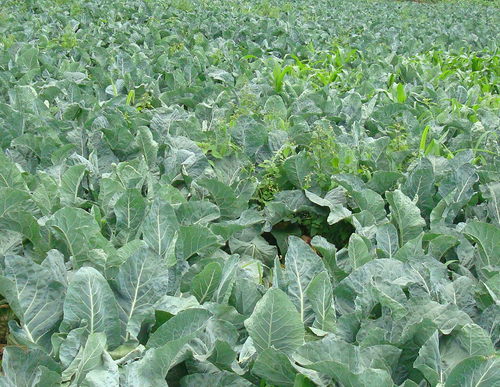Occurrence and control of cauliflower black rot and sclerotinia
The incidence of plants in the main broccoli production area is getting higher and higher. The main diseases are black rot and sclerotinia. They have a long period of damage. The incidence rate in severe years is as high as 50% to 60%, which directly affects the yield, quality and retention of broccoli. The yield and quality of seeds pose a great threat to the production and retention of broccoli. The occurrence and prevention of this is now described below.

Cauliflower black rot
The pathogen can survive in the seed or with the undecomposed diseased body in the soil for winter, through seeds, insects, rainwater and artificial propagation, invading from the wound or leaf edge water hole, and then entering the vascular bundle tissue to expand to form a systemic infection. Field operations or wounds caused by pests are more conducive to the invasion of germs.
The growth and development temperature of the pathogen is 25-30 °C, and the lethal temperature is 51 °C (10 min), which is resistant to dry environment and has a long incubation period. High temperature and high humidity are beneficial to the disease, and most of the plants begin to appear in the rosette stage or the ball-forming stage, mainly causing damage to the leaves, and the incidence rate is 20% to 60%. In general, the flower balls are less likely to develop in the field. The incidence rate of the plants in the planting area can reach 7% to 45%, causing a large loss to the seed.
Cauliflower sclerotinia
The pathogens are mainly left in the soil by sclerotia or mixed in the seeds for summer or wintering, and can also be wintered on the remaining plants. The germinated sclerotia produces a sac sac disk. The spores in the disk are ejected and then ejected by airflow. First, they are infected by weak leaves and petals to obtain nutrients, and then they are capable of infecting by hyphae. Contact is infested by mycelium.
The sclerotia of the pathogen is suitable for germination at 5-20 °C, 15 °C is most suitable, relative humidity is required to be above 70%, hyphae is not resistant to dryness, relative humidity is below 70%, and sclerotia is 50 °C for 5 minutes. Lethal, low temperature and high humidity are beneficial to the disease. The degree of hazard varies according to the climate, variety and cultivation conditions of the year, and the disease rate is 3% to 50%. In the diseased plants, the seeds of the whole plant are 30% to 50%, and the rest are mostly branches or seed pods.

Control method
The black rot and sclerotinia sclerosis of broccoli are all invasive diseases, and the law of onset has its common characteristics. The prevention and treatment are mainly based on prevention, supplemented by comprehensive prevention and control. In particular, it is necessary to pay attention to agricultural control. When selecting chemical control, biological agents are preferred to reduce environmental pollution and prevent disease occurrence.
Agricultural control
1 Selection of disease-resistant varieties Currently, the varieties that are more resistant to diseases include the farmers' series, the Xiahua series, and the Xiahua No.6. Generally, the resistance of the hybrid varieties is stronger than that of the conventional varieties.
2 Seed treatment Before sown, 10% saline or 10% to 20% ammonium sulfate water was used to rinse the sclerotium mixed in the seed, and then 45% dexamethasone water 300 times, or 0.1% strong chlorin, or 200 mg/ L agricultural streptomycin solution was soaked for 20 minutes, then washed and dried for sowing, or seed dressing with 50% Fumex WP of 0.4% of seed weight.
3 Reasonable rotation and rotation of non-cruciferous vegetables, where conditions permit, water and drought rotation can be carried out to reduce the initial source of infection in the soil.
4 Sorghum cultivation is carried out by deep sorghum cultivation, reasonable close planting, timely drainage after rain, reducing field humidity to control the propagation and spread of pathogens.
5 Reasonable fertilization in the middle and late stages to avoid partial application of nitrogen fertilizer, increase the application of phosphorus and potassium fertilizer, promote plant growth and robustness, and improve plant disease resistance.
6 Clean up the diseased leaves and old leaves in time during the period of gardening, thoroughly clean up the sick plants after harvesting, deepen the land, and reduce the source of infection.
Chemical control
In the early stage of the disease, it is necessary to spray the drug in time to prevent the spread of the disease. The vegetable plants that have already started to be infected and the surrounding healthy plants should be sprayed with special focus. Generally, the drug is sprayed once every 7 to 10 days, for 3 to 4 times in a row, and the medicament should be rotated.
1 control black rot can choose double-type Bordeaux mixture, agricultural streptomycin 200 ~ 300 units, 77% can kill WP 600 times solution, 50% Fumei double WP 500 times solution, 50% sterilization 600 to 800 times liquid, 50% of the ruthenium wettable powder 500 to 600 times liquid and other pharmaceutical sprays.
2 for the prevention and treatment of sclerotinia sclerotiorum, 50% quick-acting WP 1500-2000 times liquid, 40% sclerotium net wettable powder 500-1000 times liquid, 12.5% ​​diniconazole wettable powder 3000-4000 times liquid, 53 % Jinledomir WP 600-800 times solution, 50% chlorhexidine (isobacteria) WP 1000 times solution and other pharmaceuticals. And focus on spraying the middle and lower parts of the plant body and the surface.
Organic Buckwheat Grass Powder
Organic Buckwheat Grass Powder,Buckwheat Leaf Powder,Young Buckwheat Grass Powder,Buckwheat Young Leaf Powder
Hengshui Shanzhi Health Drink Co., Ltd , https://www.grasspowder-sz.com
